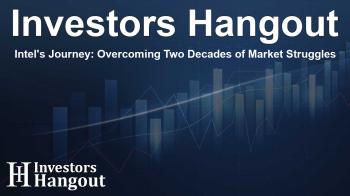Intel's Journey: Overcoming Two Decades of Market Struggles

Intel's Long Road to Recovery
Intel has faced significant challenges over the past two decades. Its stock performance has been lackluster, rising only 2% compared to the NASDAQ 100, which has surged over 1,200%. This stark contrast raises questions about Intel's strategic decisions and future direction. Intel's leadership has stumbled in crucial areas that have allowed competitors like Taiwan Semiconductor, Nvidia, and AMD to seize market share and innovate effectively.
Key Challenges Faced by Intel
Strategic Missteps
The company's reluctance to partner with Apple in providing chips for the iPhone, which emerged as a groundbreaking product in 2007, represents one of many pivotal missteps. Additionally, Intel's slow adoption of advanced manufacturing technologies such as extreme ultraviolet lithography (EUV) left it vulnerable.
Competitor Advancements
Nvidia's GPUs have dominated the AI market, leaving Intel's Gaudi AI accelerators attempting to catch up. Furthermore, AMD has effectively chipped away at Intel's market share in CPUs for personal and server computing, showcasing the urgent need for Intel to innovate.
Intel's Future Initiatives
Despite these setbacks, Intel is actively working to reclaim its position in the tech landscape by focusing on several areas:
Foundry Services
Intel aims to become a key player in the chip foundry business, leveraging partnerships with major companies like Amazon and Microsoft. Having its operations based in the U.S. may offer a competitive edge over foreign rivals.
Advancements in AI Technology
The enhancement of the Gaudi 3 AI accelerator is a critical focus for Intel, as it seeks to bolster its competitiveness against industry leaders like Nvidia. This tech evolution is crucial for capturing a portion of the expanding AI market.
Leadership Changes
A fresh start with new CEO Lip-Bu Tan, who took the reins in March, brings renewed hope for strategic shifts that may lead Intel to more favorable outcomes.
Anticipated Growth in the PC Market
After years of stagnation, the PC market is projected for a resurgence. Intel is banking on its redesigned Core series to invigorate sales and regain consumer interest.
The Risks and Rewards Ahead
While Intel shares are currently undervalued, this is often reflective of the significant challenges it faces. The ongoing investments in new initiatives could lead to increased debt and negative cash flows, creating a precarious situation for shareholders. The success of these strategies will be critical; failure may lead to prolonged underperformance.
What to Monitor Going Forward
Earnings and Economic Reports
- No earnings or significant economic reports are scheduled today.
The Upcoming Week's Insights
This week promises to be pivotal as we look forward to the jobs report and consider its implications for economic policy and market sentiment. How these figures align with recent trends will greatly impact investor confidence moving forward.
Understanding Annuities
The mention of annuities can evoke a range of feelings, from skepticism to outright dismissal. However, it's important to reassess their value in financial planning. Many perceive annuities, influenced by powerful figures in the financial sphere who denounce them, often without a thorough understanding of their benefits.
Final Thoughts
As Intel charts a path through its historical challenges, the company's efforts to innovate and stabilize amidst a highly competitive landscape are crucial. Only time will tell if these efforts are sufficient for a turnaround.
Frequently Asked Questions
What is Intel's stock performance over the last 20 years?
Intel's stock has seen only a 2% increase over the last two decades, contrasting sharply with the NASDAQ 100's over 1,200% rise.
What major mistakes has Intel made?
Key errors include not supplying chips for the iPhone and delaying the adoption of advanced EUV technology.
How is Intel addressing its challenges?
Intel is focusing on enhancing its AI technology, entering the foundry market, and revitalizing its PC lines.
Who is the current CEO of Intel?
Lip-Bu Tan is the CEO of Intel, having taken office in March.
What can investors expect from Intel moving forward?
If Intel's new initiatives succeed, it could lead to significant growth. Conversely, failure may extend its period of underperformance.
About The Author
Contact Kelly Martin privately here. Or send an email with ATTN: Kelly Martin as the subject to contact@investorshangout.com.
About Investors Hangout
Investors Hangout is a leading online stock forum for financial discussion and learning, offering a wide range of free tools and resources. It draws in traders of all levels, who exchange market knowledge, investigate trading tactics, and keep an eye on industry developments in real time. Featuring financial articles, stock message boards, quotes, charts, company profiles, and live news updates. Through cooperative learning and a wealth of informational resources, it helps users from novices creating their first portfolios to experts honing their techniques. Join Investors Hangout today: https://investorshangout.com/
The content of this article is based on factual, publicly available information and does not represent legal, financial, or investment advice. Investors Hangout does not offer financial advice, and the author is not a licensed financial advisor. Consult a qualified advisor before making any financial or investment decisions based on this article. This article should not be considered advice to purchase, sell, or hold any securities or other investments. If any of the material provided here is inaccurate, please contact us for corrections.

